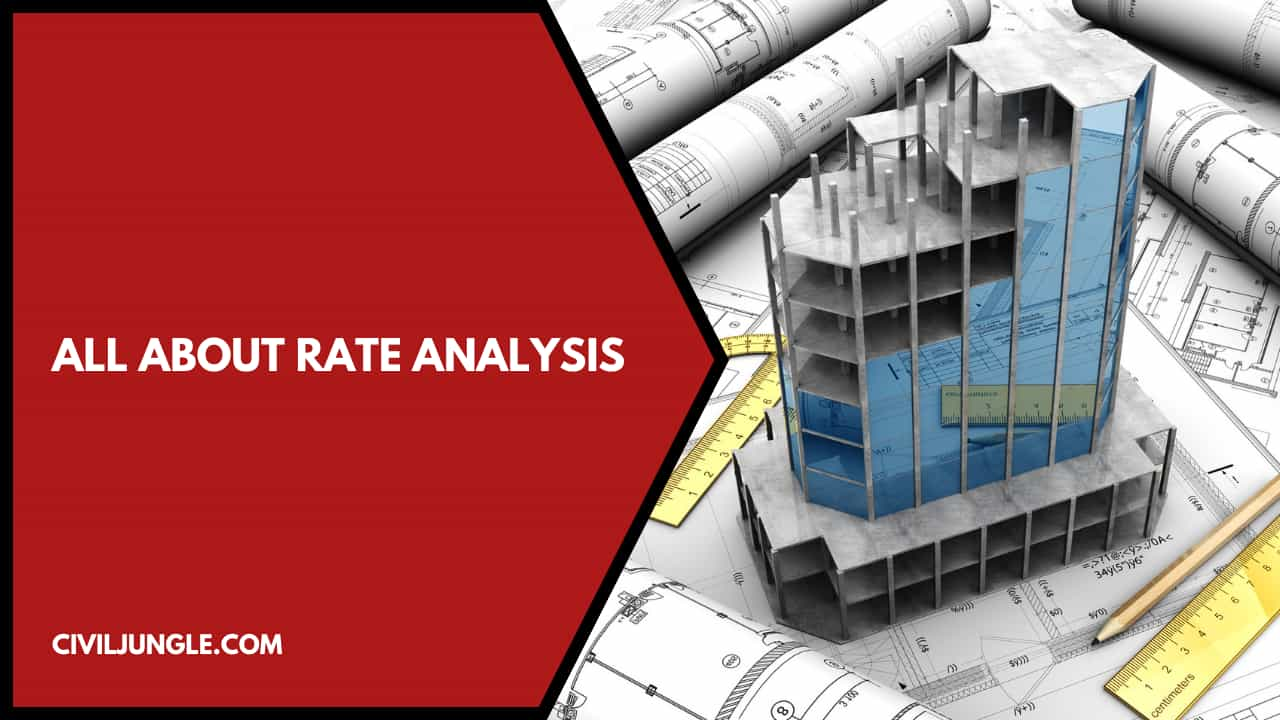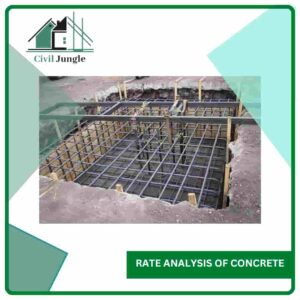What is Rate Analysis?
Important Point
The basis of arriving at a correct and reasonable rate per unit. Work or supply for a particular item following its specification and detailed survey of materials, labour, equipment, etc. as required for the unit work, and their prevailing rates may be called as an analysis of rate.
The procedure of analyzing the rate per unit of an item has been described.
This consists of the following heads:—
- Quantity of materials required per unit rate of work and its cost delivered at work site including first cost, freight, transportation, sales tax, and insurance charges as artists in question. In case when materials like cement, steel, stone chips, and bitumen are supplied departmentally, then profit on the cost of materials is not allowed, but the cost of carriages from godown to work site shall be added.
- A number of labour or labour hours required to complete per unit rate of work and its cost.
- Overhead or equipment and establishment charges required to complete per unit rate of work.
- Profit while arriving at workable rates, the factors that are to be considered have already been described.
- In this rate analysis, all civil items consider and all items for different rate analysis sum major rate analysis as per below.
- Rate Analysis of Earth Work.
- Rate Analysis of Brick.
- Rate Analysis of Concrete.
- Rate Analysis of Plaster.
Also, read: First Angle Projection & Third Angle Projection Symbol (Orthographic Projection)
Rate Analysis of Earth Work.
- As per below rate analysis of earthwork
- Earthwork in an excavation in all kinds of soil including banking in 20 cm layers and breaking clods, ramming and dressing up for the purpose of making embankments or filling up ground depressions, lead upto 50 m and lift upto 1.50 m.
- As per CPWD minimum labour requirement of 1 cu.m. excavation man labour 0.21 per day and female labour 0.14 per day.
- Required other charges 2 %, Add for Water Charge @ 1% on Items Marked, Add for Contractor’s Profit @15% on Items Marked.
- All Calculation for read Click here.
| Sr No. | Description | Qty | Unit | Rate | Cost |
| Details of cost for 28.34 Cu.m. | |||||
| A | Labour Charges | ||||
| 1 | Man Labour | 6.00 | Day | 400.00 | 2400.00 |
| 2 | Female Labour | 4.00 | Day | 350.00 | 1400.00 |
| B | Other Charges 2 % Extra | 76.00 | |||
| C | Add for Water Charge @ 1% on Items Marked | 38.00 | |||
| D | Add for Contractor’s Profit @15% on Items Marked | 570.00 | |||
| Cost of 28.34 Cu.m. | 4484.00 | ||||
| Cost of Cu.m. | 158.22 | ||||
| Round off Cu.m. | 158.00 | ||||
Also, read: Principle of Plane Table Surveying Methods |Equipment | Error | Advantage | Limitation
Rate Analysis of Brick.
- As per below rate analysis of brick
- Brickwork with best available local bricks in foundation and plinth in cement mortar 1:3 (1
cement : 3 fine sand) - Rate analysis of Brickwork minimum labour requirement 10 cu.m. as below Bhisti 1.80 nos, Coolie 10.00 nos, Mason 3.3 nos, and Helper 3.3 nos. this above labour calculation use experience also recommend by CPWD
- Required other charges 2 %, Add for Water Charge @ 1% on Items Marked, Add for Contractor’s Profit @15% on Items Marked, Transportation Cost 1%, Scaffolding 1% Extra.
- All Calculation for read Click here.
| Sr No. | Description | Qty | Unit | Rate | Cost |
| Brickwork with best available local bricks in foundation and plinth in cement mortar 1:3 (1 cement : 3 fine sand) | |||||
| Details of cost for 10.00 Cu.m. | |||||
| A | Labour Charges | ||||
| 1 | Baathist | 1.80 | Day | 350.00 | 630.00 |
| 2 | Coolie | 10.00 | Day | 350.00 | 3500.00 |
| 3 | Mason | 3.30 | Day | 700.00 | 2310.00 |
| 4 | Helper | 3.30 | Day | 350.00 | 1155.00 |
| B | Material | ||||
| 1 | Bricks | 4940 | Nos | 5.00 | 24700.00 |
| 2 | Cement | 21 | Bag | 280.00 | 5880.00 |
| 3 | Sand | 2.8 | Cu.m. | 850.00 | 2380.00 |
| C | Scaffolding 1% Extra | 1% | 329.60 | ||
| D | Transportation Cost 1% | 1% | 329.60 | ||
| E | Other Charges 2 % Extra | 2% | 659.20 | ||
| F | Add for Water Charge @ 1% on Items Marked | 1% | 329.60 | ||
| G | Add for Contractor’s Profit @15% on Items Marked | 15% | 4944.00 | ||
| Cost of 10.00 Cu.m. | 47147.00 | ||||
| Cost of Cu.m. | 4714.70 | ||||
| Round off Cu.m. | 4715.00 | ||||
Also, read: What Is a Bar Bending Schedule | Preparation as Per Bs 4466 | Tolerances as Per Bs 4466
Rate Analysis of Concrete.
- As per below rate analysis of concrete
- Providing and laying in foundations and plinth cement concrete 1: 5: 10 (1 cement: 5 coarse sand: 10 graded stone aggregate 20 mm nominal & 40mm size) excluding the cost of centering and shuttering.
- Required other charges 2 %, Add for Water Charge @ 1% on Items Marked, Add for Contractor’s Profit @15% on Items Marked, Transportation Cost 1%, Wastage Extra Total Cost of 5%.
- All Calculation for read Click here.
| Sr No. | Description | Qty | Unit | Rate | Cost |
| Providing and laying in foundations and plinth cement concrete 1: 5: 10 (1 cement: 5 coarse sand: 10 graded stone aggregate 40 mm & 20 mm nominal size) excluding the cost of centering and shuttering. | |||||
| Details of cost for 10.00 Cu.m. | |||||
| A | Labour Charges | ||||
| 1 | Baathist | 2.70 | Day | 350.00 | 945.00 |
| 2 | Coolie | 6.00 | Day | 350.00 | 2100.00 |
| 3 | Balder | 9.00 | Day | 350.00 | 3150.00 |
| 4 | Mason | 0.5 | Day | 700.00 | 350.00 |
| 5 | Helper | 0.5 | Day | 400.00 | 200.00 |
| 6 | Mate | 0.4 | Day | 500.00 | 200.00 |
| B | Material | ||||
| Cement | 18.00 | Bag | 280.00 | 5040.00 | |
| Sand | 3.13 | Cu.m. | 850.00 | 2656.25 | |
| Aggregate | 6.25 | Cu.m. | 735.00 | 4593.75 | |
| C | Wastage Extra Total Cost of 5% | 5% | 961.75 | ||
| D | Transportation Cost 1% | 1% | 122.90 | ||
| E | Other Charges 2 % Extra | 2% | 245.80 | ||
| F | Add for Water Charge @ 1% on Items Marked | 1% | 122.90 | ||
| G | Add for Contractor’s Profit @15% on Items Marked | 15% | 1843.50 | ||
| Cost of 10.00 Cu.m. | 22531.85 | ||||
| Cost of Cu.m. | 2253.19 | ||||
| Round off Cu.m. | 2253.00 | ||||
Also, read: What Is Linear Measurement Surveying | Type of Linear Measurement Surveying
Rate Analysis of Plaster.
- As per below rate analysis of plaster
- Providing and laying in 12 mm thick plasterwork 1: 4 (1 cement: 4 coarse sand: 1) excluding the cost of with material.
- All Calculation for read Click here.
| Sr No. | Description | Qty | Unit | Rate | Cost |
| Providing and laying in 12 mm thick plasterwork 1: 4 (1 cement: 4 coarse sand: 1) excluding the cost of with material. | |||||
| Details of cost for 100.00 sq.m. | |||||
| A | Labour Charges | ||||
| 1 | Mason | 6.70 | Day | 700.00 | 4690.00 |
| 2 | Bhisti | 9.20 | Day | 400.00 | 3680.00 |
| 3 | Coolie | 7.50 | Day | 400.00 | 3000.00 |
| B | Material | ||||
| Cement | 9.00 | Bag | 280.00 | 2520.00 | |
| Sand | 1.248 | Cu.m. | 850.00 | 1060.80 | |
| C | Wastage of Material 2% | 2% | 71.62 | ||
| D | Scaffolding 1% Extra | 1% | 35.81 | ||
| E | Transportation Cost 1% | 1% | 35.81 | ||
| F | Other Charges 2 % Extra | 2% | 71.62 | ||
| G | Add for Water Charge @ 1% on Items Marked | 1% | 35.81 | ||
| H | Add for Contractor’s Profit @15% on Items Marked | 15% | 537.12 | ||
| Cost of 100.00 Sq.m. | 15738.58 | ||||
| Cost of Sq.m. | 157.39 | ||||
| Round off Sq.m. | 157.00 | ||||
Also Read: Plaster Ratio
Rate Analysis of Civil Works
Civil Rate Analysis – Construction Cost Estimation is an application that can be used to estimate the cost of construction of different civil engineering works such as overall house building cost and cost estimation based on particular category of construction.
Rate Analysis in Civil Engineering
Rate analysis helps in proportioning the effect of the market on the payments made for construction work. It also helps in determining the construction costs per unit as stipulated in the specifications. The use of rate analysis makes it possible to come up with uniform standards for construction works.
Define Rate Analysis
Rate analysis is the basis for arriving at a correct rate per unit work or supply of work specifications such as labor, materials, and equipment. It can also be defined as the analytical study that leads to the definition of unit rates of work by identifying the basic requirements.
What Is Rate Analysis in Civil Engineering?
Rate analysis, the details about all the operation involved in carrying out the work should be available. The quantities of materials required and their cost should be known and the number of different categories of labours required and the capacity of doing work per labour and their wages per day should be known.
Rate Analysis Is Done for Finding
Rate Analysis is done to know the current rate of any material.
What Are the Pre-Requisites to Carry Out Rate Analysis?
Here, the list of pre-requisites to carry out rate analysis are as follows.
- Cost of Material.
- Cost of Labor.
- Cost of Equipment.
- Overhead Charges.
- Contractor’s Profit.
Rate Analysis in Construction
Pre-construction document and cost analysis is a detailed analysis of the project’s budget estimate, the schedule of values, the construction team, the scope of work, the owner/contractor agreement, the plans and specifications, timeline, and materials in order to determine its constructability.
Civil Rate
Construction Cost Estimation is an application that can be used to estimate the cost of construction of different civil engineering works such as overall house building cost and cost estimation based on particular category of construction.
Rate Analysis for Construction
Rate analysis helps in proportioning the effect of the market on the payments made for construction work. It also helps in determining the construction costs per unit as stipulated in the specifications.
Water Charges in Rate Analysis
Water Charges in Estimation = 1.5 to 2 % 0f the total cost
What Is Rate Analysis in Construction?
Rate analysis is the basis for arriving at a correct rate per unit work or supply of work specifications such as labor, materials, and equipment. It can also be defined as the analytical study that leads to the definition of unit rates of work by identifying the basic requirements.
Procedure of Rate Analysis
The analysis of rates is worked out for the unit payment of the particular item of work under two heads: Materials and Labour.
- The cost of items of work = Material cost + Labour cost
- Other costs included to the above cost of items of work are:
- Tools and Plants ( T & P ) = 2.5 to 3 % of the labour cost
- Transportation cost (if conveyance more than 8 km is considered.)
- Water charges = 1.5 to 2 % 0f total cost
- Contractor’s profit = 10 %
Requirements of Rate Analysis
The rate analysis may be required in construction projects for the following purposes:
- To compare a project’s cost with the project’s sanctioned capital to take necessary action or regularization of excess or less cost.
- To workout the budget of the construction project and control the cash flows at various stages of construction work.
- To find out the irrational rates quoted by the contractors during tendering process.
- To serve as the basic data in case of dispute between project owner and contractor.
- For the purpose of tendering. In the case of tendering, the contractor may calculate cost of unit work involved in each construction activity for justified quoting of rates. The client may also require rate analysis to calculate the cost of a construction project.
- To assess the requirements of quantities of labour, materials, machinery and capital to complete the project.
- To optimize the use of labor, materials and machinery and to know the alternatives to optimize the resources.
- To assess the rate of unit work from time to time for payment increase in material or labor costs or any deviations in work specifications, extra items of work to the contractor.
What Is Analysis of Rate?
Rate analysis is the basis for arriving at a correct rate per unit work or supply of work specifications such as labor, materials, and equipment. It can also be defined as the analytical study that leads to the definition of unit rates of work by identifying the basic requirements.
Rate Analysis Definition in Civil Engineering
Rate analysis is the basis for arriving at a correct rate per unit work or supply of work specifications such as labor, materials, and equipment.
Contractor’s Profit in Rate Analysis
Depending on the scale of the project and your local industry, the Contractors Profit in Rate Analysis should comprise about 8-15% of the entire project.
Rate Analysis Is Defined as
Rate Analysis can be defined as the analytical study (qualitative and quantitative) that leads to the definition of a new unit rate referring to a given job or work type, by identifying its basic elements.
Mention the Two Heads in the Analysis of Rates Mens
The analysis of rates is worked out for the unit payment of the particular item of work under two heads: Materials and Labour. The rate of various materials as per specifications for the items under consideration can be chalked out from market survey. The costs of materials are taken as delivered at site of work.
Labour Rate Analysis Civil Work
The rate of labour is based on skills of the labour, such as skilled labour, semi-skilled and unskilled labour. The cost of materials and labours vary from place to place. Thus, the cost of each construction work varies from place to place.
Unit Rate Analysis
Unit rate analysis means the rate of all work. As we are doing the work of concrete casting. So what is the rate at which it works? If the rate is divided into units, it is called unit rate. Example: 1 cu.m. concrete casting rate this concrete rate is the unit rate.
Rate Analysis of Plaster
Rate analysis of plaster refers to the process of determining the cost of plastering work for a given area. It involves breaking down the various components of plastering, such as materials, labor, and overheads, and calculating the cost associated with each component. The rate analysis helps in estimating the total cost of the plastering work and is useful for budgeting and cost control purposes.
What Is Rate Analysis?
Rate analysis is a systematic process used in construction and engineering projects to determine the cost of various components involved in the project. It involves breaking down the project into smaller elements and quantifying the materials, labor, equipment, and overheads required for each element. The objective of rate analysis is to calculate the unit cost or rate for each component, which helps in estimating the total cost of the project, budgeting, and cost control.
Analysis of Rates
The analysis of rates provides a detailed understanding of the costs associated with different items or activities in a project. It helps in budgeting, cost control, and decision-making during the project planning and execution phases. The analysis of rates is essential for preparing accurate project estimates, tendering, pricing, and ensuring the financial viability of the project.
Rate Analysis in Estimation
- Item Breakdown
- Quantity Determination
- Rate Calculation
- Cost Estimation
Rate Analysis for Civil Works
Break down the project into specific civil works or activities. This includes identifying and listing the various tasks involved in the project, such as excavation, foundation work, concrete work, brickwork, plastering, flooring, roofing, plumbing, electrical work, painting, etc.
Rate Analysis Definition
Rate analysis is a systematic process of determining the costs or rates associated with different components of a construction project. It involves breaking down the project, quantifying materials, labor, and equipment for each component, and calculating unit costs. It helps estimate total project costs and is crucial for budgeting, tendering, pricing, and cost control.
Requirements of Rate Analysis
Factors which affect the rate analysis of civil works are:
Quantity of materials, number of different types of labours and rates of materials and labours influence the rate analysis. Profit of the contractor, miscellaneous expenses and other overheads also influence the rate analysis.
Analysis of Rates for Building Works
Analysis of rates for building works is the process of separation of works into components/elements (Viz. Labour, materials, machinery,transport, overheads and profit) of work and pricing them.
Procedure of Rate Analysis
- Itemization
- Quantification
- Rate Calculation
- Cost Analysis
What Is Rate Analysis in Estimation?
Calculating the rates for labor, materials, equipment, and overheads associated with each item or activity. These rates are typically derived from market rates, supplier quotations, historical data, or industry standards. The rates are expressed per unit, such as per square meter, per cubic meter, per piece, or per hour.
Civil Rate Analysis
Rate analysis of Civil Works or Building Works is the determination of cost of each construction work per unit quantity. This cost includes the cost of materials, labours, machinery, contractors profit and other miscellaneous petty expenses required for the particular work to be complete in unit quantity.
Rate Analysis in Estimation and Costing
Estimation is the process of finding the required quantity of materials needed for your construction and rate analysis is the method to find the price of each for your constructional unit. The estimation and costing have done with the help of a project estimator.
Explain Rate Analysis
Rate analysis is a systematic process used in construction and engineering projects to determine the cost or rate per unit of work. It involves analyzing and evaluating the various components, materials, labor, and equipment required for a particular task or activity. The purpose of rate analysis is to estimate the cost of the project accurately, establish unit rates for different elements, and facilitate effective budgeting, tendering, pricing, and cost control.
How to Do Rate Analysis for Civil Works?
The cost of materials in rate analysis is calculated as combination of cost of material at origin, its transportation costs, taxes. The rate of labour is based on skill of the labour, such as skilled labour, semi-skilled and unskilled labour. The cost of materials and labours vary from place to place.
Like this post? Share it with your friends!
Suggested Read –
- Rate Analysis
- Rate Analysis of Concrete
- What is Consistency of Cement
- What Is Cement | Type of Cement
- What Is Soundness of Cement Test
- What Is Water Cement Ratio | Water-Cement Ratio and Concrete Strength | Role of Water in Concrete
- What Is Unit Weight | What Is Density | What Is Unit Weight Material | Unit Weight Building Materials







Leave a Reply